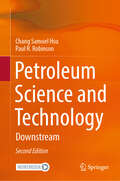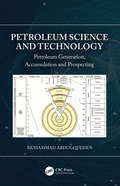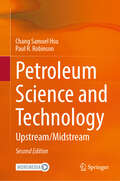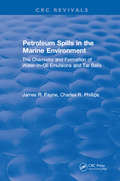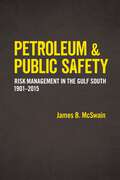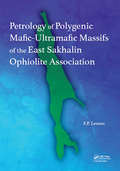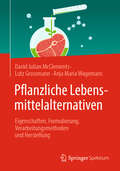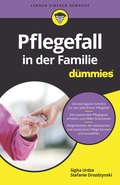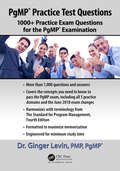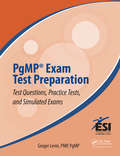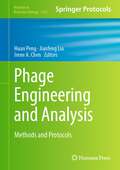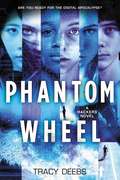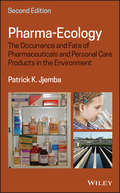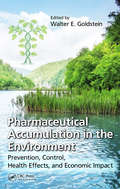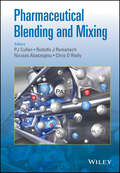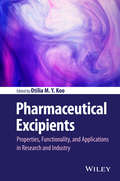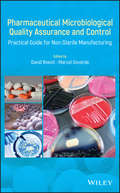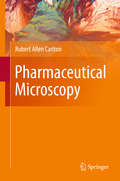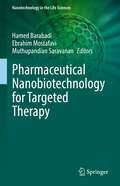- Table View
- List View
Petroleum Science and Technology: Downstream
by Chang Samuel Hsu Paul R. RobinsonAimed at students and professionals, this book provides an overview of the science and technology of the downstream sector of the oil and gas industry. Topics include the refining of crude oil and other feedstocks – including renewables – into fuels and lubricants. They also describe the conversion of simple chemicals into solvents, polymers, fibers, rubbers, coatings, and myriad other products, including pharmaceuticals.In addition to drawing on the authors' previous books, it includes teaching material from several courses. These include workshops provided for top refining companies and a highly rated course taught at the Florida A&M University/Florida State University (USA).
Petroleum Science and Technology: Petroleum Generation, Accumulation and Prospecting
by Muhammad Abdul QuddusPetroleum Science and Technology: Petroleum Generation, Accumulation and Prospecting describes natural hydrocarbon geology along with applicable aspects of physics, chemistry, biology, environmental science, mathematics, and engineering/technology. It starts off with a brief coverage of the origin and evolution of the universe, petroleum origin and generation in subsurface condition, source rock, oil/gas migration path and reservoir rock. Geological, geophysical, and geochemical petroleum surveys are also included. This book covers both theory and applied information. Aimed at graduate students, researchers, and professionals in petroleum engineering and chemical engineering, it: Covers petroleum geology and technology including petroleum generation, migration, and reservoir formation Introduces the nature and formation of petroleum and its exploration Describes oil/gas prospecting using geophysico-chemical methods under subsurface condition Includes a detailed geochemical survey along with an analysis of kerogen and bitumen Explains petroleum migration and accumulation using two-dimensional graphs MA Quddus PhD, has served in the petroleum sector and R&D organization, both national and multinational, for more than 40 years and has worked in various capacities including in the laboratory, office, field, and plant, and has also engaged in teaching petroleum technology as a visiting professor for 17 years. He earned BSc (Hons) and MSc degrees along with a PhD with thesis titled "Oxidation of Asphalt." As a result of his constant research, he has published nine international and 12 national papers, obtained one patent, presented five papers in conferences and prepared six technical reports. He has also visited the USA, Canada, and Indonesia for short courses in petroleum technology and teacher training.
Petroleum Science and Technology: Upstream / Midstream
by Chang Samuel Hsu Paul R. RobinsonAimed at students and professionals, this book provides an overview of the science and technology of the upstream/midstream sectors of the oil and gas industry. Topics include the origin of fossil hydrocarbons and their chemical/physical properties; discovering hydrocarbon reserves; recovering oil, gas and bitumen; and purifying natural gas and process offgas. The chapter on safety and the environment convers safety regulations and environmental laws. It highlights learnings from major accidents. In addition to drawing on the authors' previous books, it includes teaching material from several courses. These include workshops provided for top petroleum companies and a highly rated course taught at the Florida A&M University/Florida State University (USA).
Petroleum Spills in the Marine Environment: The Chemistry and Formation of Water-In-Oil Emulsions and Tar Balls
by James R. PayneThis book covers research completed between 1981 and May 1985 and includes: reviews of recent studies, sitings and investigations at spills-of-opportunity as well as results of recent arctic and sub-Arctic oil weathering experiments and observations on the behavior of crude oil in the presence of ice. Topics covered include the following: laboratory studies of formation and stability of water-in-oil emulsions; selected case histories of the more detailed chemistry studies of mousse behavior and long term fate in near-coastal and open ocean oil spills/blowouts; tar ball formation and distribution; and algorithms and computer programs to simulate the formation of water-in-oil emulsion.
Petroleum and Gas Field Processing (ISSN)
by Hussein K. Abdel-Aal Mohamed A. Aggour Mohamed A. FahimMany oil production processes present a significant challenge to the oil and gas field processing facilities and equipment design. The optimization of the sequential operations of handling the oil–gas mixture can be a major factor in increasing oil and gas production rates and reducing operating costs.Petroleum and Gas Field Processing provides an all-inclusive guide to surface petroleum operations and solves these and other problems encountered in the field processing of oil and gas. Fully revised and updated to reflect major changes over the past decade or so, this second edition builds on the success attained in the first edition. It delivers an expanded and updated treatment that covers the principles and procedures related to the processing of reservoir fluids for the separation, handling, treatment, and production of quality petroleum oil and gas products.With five new chapters, this second edition covers additional subjects, in particular natural gas, economics and profitability, oil field chemicals, and piping and pumps. The book also contains worked-out examples and case studies from a variety of oil field operations.
Petroleum and Marine Technology Information Guide: A bibliographic sourcebook and directory of services
by J. Hutcheon A. Myers S. Oue B. Rodden J. WhittickFirst published in 1981 as the Offshore Information Guide this guide to information sources has been hailed internationally as an indispensable handbook for the oil, gas and marine industries.
Petroleum and Public Safety: Risk Management in the Gulf South, 1901-2015 (Making the Modern South)
by James B. McSwainThroughout the twentieth century, cities such as Houston, Galveston, New Orleans, and Mobile grappled with the safety hazards created by oil and gas industries as well as the role municipal governments should play in protecting the public from these threats. James B. McSwain’s Petroleum and Public Safety reveals how officials in these cities created standards based on technical, scientific, and engineering knowledge to devise politically workable ordinances related to the storage and handling of fuel.Each of the cities studied in this volume struggled through protracted debates regarding the regulation of crude petroleum and fuel oil, sparked by the famous Spindletop strike of 1901 and the regional oil boom in the decades that followed. Municipal governments sought to ensure the safety of their citizens while still reaping lucrative economic benefits from local petroleum industry activities. Drawing on historical antecedents such as fire-protection engineering, the cities of the Gulf South came to adopt voluntary, consensual fire codes issued by insurance associations and standards organizations such as the National Board of Fire Underwriters, the National Fire Protection Association, and the Southern Standard Building Code Conference. The culmination of such efforts was the creation of the International Fire Code, an overarching fire-protection guide that is widely used in the United States, Mexico, the Caribbean, and Central America. In devising ordinances, Gulf South officials pursued the politics of risk management, as they hammered out strategies to eliminate or mitigate the dangers associated with petroleum industries and to reduce the possible consequences of catastrophic oil explosions and fires.Using an array of original sources, including newspapers, municipal records, fire-insurance documents, and risk-management literature, McSwain demonstrates that Gulf South cities played a vital role in twentieth-century modernization.
Petrology of Polygenic Mafic-Ultramafic Massifs of the East Sakhalin Ophiolite Association
by Felix P. LesnovThe monograph is concerned with results of studies of petrology of mafic-ultramafic massifs as part of the East Sakhalin ophiolite association. It generalizes and interprets a large body of data (mainly original data) on geology, petrography, petrochemistry, and geochemistry of rocks; mineralogy and geochemistry of rock-forming and accessory minerals; chromite and platinum contents, and isotopic age of zircons from rocks of the typical mafic-ultramafic massifs of the East Sakhalin ophiolite association: Berezovka, Shel’ting, Komsomol’sk, and South Schmidt. Gabbroids from the Berezovka massif contain ultramafic xenoliths. Ultramafic rocks are locally cut by gabbroid and pyroxenite veins. Three spatially close but genetically autonomous bodies are distinguished in the structure of the massifs under study: protrusion of upper-mantle restitic ultramafic rocks (harzburgites, lherzolites, and dunites); intrusion of orthomagmatic gabbroids (gabbronorites, gabbro, and norites) that cuts it; and contact-reaction zone, located along the boundaries between gabbroid intrusion and ultramafic protrusion, which consists of hybrid ultramafic rocks (wehrlites, websterites, clinopyroxenites, and their olivine- and plagioclase-containing varieties) and hybrid gabbroids (melano- and mesocratic olivine gabbronorites and gabbro as well as troctolites). The hybrid ultramafic rocks and gabbroids are the product of interaction between mafic melts and restitic ultramafic rocks. Taking into account the later formation of the gabbroid intrusions compared to the ultramafic protrusions, the massifs in question are determined as polygenic. The idea of their polygenic formation is supported by data on the isotopic age of zircons from the Berezovka massif rocks. In this monograph the author develops his earlier proposed concept of polygenic formation of mafic–ultramafic massifs belonging to ophiolite associations. The book addresses a wide circle of petrologists and practicing geologists as well as senior-year students and postgraduates studying problems of mafic-ultramafic magmatism.
PfMP Exam Practice Tests and Study Guide (Best Practices in Portfolio, Program, and Project Management)
by PMP, PgMP, LevinRecognizing the importance of portfolio management, the Project Management Institute (PMI) has launched a new certification entitled the Portfolio Management Professional (PfMP). PfMP Exam Practice Tests and Study Guide is the most comprehensive resource available to help you prepare for and pass the PfMP certification exam. It provides covera
Pflanzliche Lebensmittelalternativen: Eigenschaften, Formulierung, Verarbeitungsmethoden und Herstellung
by David Julian McClements Lutz Grossmann Anja Maria WagemansDie Entwicklung pflanzlicher Lebensmittelalternativen ist eines der am schnellsten fortschreitenden Gebiete in unserem modernen Ernährungssystem. Viele Verbraucher*innen reduzieren den Konsum von tierischen Lebensmitteln und greifen vermehrt zu pflanzlichen Alternativen. Die Lebensmittelindustrie greift dieses Konsummuster auf und bietet zunehmend innovative pflanzliche Alternativprodukte an. Die Entwicklung und Herstellung dieser alternativen Lebensmittel geht jedoch mit großen Herausforderungen einher, da viele tierische Lebensmittel aus sehr komplexen Strukturen mit hochfunktionellen Inhaltsstoffen bestehen. Eine wissenschaftliche Herangehensweise ist daher eine wesentliche Voraussetzung, um pflanzliche Lebensmittelalternativen mit einer hohen Verbraucherakzeptanz und hohem Nährwert zu entwickeln.Dieses Fachbuch beschreibt die Wissenschaft und Technologie von pflanzlichen Lebensmittelalternativen. Leser*innen erhalten einen Überblick über die verwendeten Zutaten und Verarbeitungsprozesse sowie über die wichtigsten Ernährungs- und Qualitätsmerkmale spezifischer pflanzlicher Lebensmittelkategorien wie Alternativen zu Milch und Milchprodukten, Eiern und Eiprodukten sowie Fleisch und Meeresfrüchten. Fachkräfte mit Bezug zur Lebensmitteltechnologie können dieses grundlegende Wissen nutzen, um die nächste Generation gesünderer und nachhaltigerer pflanzlicher Lebensmittelalternativen herzustellen.
Pflegefall in der Familie für Dummies (Für Dummies)
by Sigita Urdze Stefanie DrozdzynskiVon einem Tag auf den anderen haben Sie plötzlich einen Pflegefall in der Familie. Wer versorgt Ihre Mutter? Wo kann Ihr Vater nun wohnen? Woher bekommen Sie Unterstützung? Und: Wer wird dies alles bezahlen? Dieses Buch hilft Ihnen - mit Checklisten für die ersten 24 Stunden, praktischen Infos zur Organisation der Pflege, Tipps, wie Sie einen angemessenen Pflegegrad für den Pflegebedürftigen bekommen und vielem mehr. Sigita Urdze und Stefanie Drozdzynski sind als pflegende Angehörige einerseits und Krankenschwester und Pädagogin in der Senioren- und Angehörigenberatung andererseits das ideale Autorenpaar: Sie erklären Ihnen alles, was Sie wissen müssen, und machen Ihnen zugleich Mut, wenn Sie meinen, nicht mehr weiter zu können.
PgMP Exam Challenge! (ESI International Project Management Series #17)
by Ginger Levin PMP PgMP J. LeRoy Ward PMP PgMPUp to date with the third edition of PMI's Program Management Standard, The PgMP Exam Challenge! contains more than 300 practice questions to help readers hone their knowledge and test their skills. It covers all five of the program management domains: Strategic Program Management, Program Management Life Cycle, Benefits Management, Stakeholder Management, and Governance. It also examines all of the sub domains of the lifecycle domain. With an easy-to-use format, this is an ideal resource for those preparing to take the PgMP exam.
PgMP Exam Practice Test and Study Guide (ESI International Project Management Series)
by Ginger Levin J. LeRoy WardUp to date with the third edition of PMI's Standard for Program Management, this is the most comprehensive resource available to help prepare readers for the PgMP Exam. Updated with new and changed terminology, this edition incorporates the concepts from the five performance domains. The book features practical study hints, a list of major topics covered on the exam, and a bibliographic reference for further study. The two challenging, 170-question practice tests are available in the book and online so readers can retake the practice tests as many times necessary.
PgMP Practice Test Questions: 1000+ Practice Exam Questions for the PgMP Examination
by Ginger LevinUp to date with the fourth edition of PMI’s Program Management Standard, PgMP® Practice Test Questions: 1000+ Practice Exam Questions for the PgMP® Examination contains more than 1,000 practice questions to help readers hone their knowledge and test their skills. It covers all five of the program management domains: Strategic Program Management, Program Management Life Cycle, Benefits Management, Stakeholder Management, and Governance. It also examines all of the sub domains of the lifecycle domain. With an easy-to-use format, this is an ideal resource for those preparing to take the PgMP® exam.
PgMP® Exam Test Preparation: Test Questions, Practice Tests, and Simulated Exams (Best Practices in Portfolio, Program, and Project Management)
by Pmp Ginger Levin PgMPIn addition to test questions in each of the five domains and two practice tests in print and online, this all-in-one study guide also contains flashcards for learning terms. This book is current with The Standard for Program Management, Fourth Edition, and its author is the second person in the world to have earned the PgMP® certification. The online versions of the practice test simulate taking the actual exams and provide scoring as above target, target, below target, or needs improvement. Answers come with explanations and references. Questions are written to improve reading skills and teach how to select the best answer, which are key to passing the exam.
Phage Engineering and Analysis: Methods and Protocols (Methods in Molecular Biology #2793)
by Huan Peng Jianfeng Liu Irene A. ChenThis volume explores the latest developments in the study and application of phage biology. The chapters in this book are divided into five parts and cover topics such as phage display, selection, and evolution; genetic and chemical modification of phages; analyzing structures by electron microscopy; characterizing phage transcripts and proteins; and the biology of whole phages. Written in the highly successful Methods in Molecular Biology series format, chapters include introductions to their respective topics, lists of the necessary materials and reagents, step-by-step, readily reproducible laboratory protocols, and tips on troubleshooting and avoiding known pitfalls.Cutting-edge and comprehensive, Phage Engineering and Analysis: Methods and Protocols is a valuable resource that will help both expert and novice researchers - from backgrounds ranging from microbiologists to biophysicists to chemical engineers - further enhance their understandingof this important and evolving field.
Phantom Orbit: A Thriller
by David Ignatius“A meaty, slow-burning spy thriller that combines geopolitics with a primer on celestial mechanics.” —Steven Poole, Wall Street Journal A subtle and masterful novel from a prescient voice on the cutting edge of spy literature. David Ignatius is known for his uncanny ability, in novel after novel, to predict the next great national security headline. In Phantom Orbit, he presents a story both searing and topical, with stakes as far-reaching as outer space. It follows Ivan Volkov, a Russian student in Beijing, who discovers an unsolved puzzle in the writings of the seventeenth-century astronomer Johannes Kepler. He takes the puzzle to a senior scientist in the Chinese space program and declares his intention to solve it. Volkov returns to Moscow and continues his secret work. The puzzle holds untold consequences for space warfare. The years pass, and they are not kind to Volkov. After the loss of his son, a prosecutor who’d been too tough on corruption, and Russia’s invasion of Ukraine, Volkov makes the fraught decision to contact the CIA. He writes: Satellites are your enemies, especially your own. . . . Hidden codes can make time stop and turn north into south. . . . If you are smart, you will find me. With this timely novel, Ignatius addresses our moment of renewed interest in space exploration amid geopolitical tumult. Phantom Orbit brims with the author’s vital insights and casts Volkov as the man who, at the risk of his life, may be able to stop the Doomsday clock.
Phantom Wheel: A Hackers Novel
by Tracy DeebsThe digital apocalypse has arrived and the future is here in this addictive technological thriller full of twists and turns. Perfect for fans of Nerve! Being recruited by the CIA to join a top-secret intelligence program should be the opportunity of a lifetime. For Issa, it's a shot at creating a new and better life for herself and her siblings. For clever con artist Harper, it's a chance to bury the secrets of her troubled past and make sure that those secrets stay buried. But for Owen--honor student, star quarterback, and computer-hacking genius--it sounds like a trap. He's right. Owen discovers that instead of auditioning for the CIA, they've all been tricked by a multibillion-dollar tech company into creating the ultimate computer virus. It's called Phantom Wheel, and it's capable of hacking anyone on Earth, anywhere, at any time. And thanks to six teenagers, it's virtually unstoppable. Horrified by what they've done, the hackers must team up to stop the virus before the world descends into chaos. But working together is easier said than done, especially as the lines start to blur between teammate, friend, and more than friend. Because how do you learn to trust someone when you've spent your entire life exploiting that same trust in others?
Pharma-Ecology: The Occurrence and Fate of Pharmaceuticals and Personal Care Products in the Environment
by Patrick K. JjembaThe revised edition of the guide to environmental impact of pharmaceuticals and personal care products The revised and updated second edition of Pharma-Ecology joins the health and environmental sciences professions' concern over the occurrence and fate of pharmaceutical and personal care products (PPCPs) in the environment and explores how to best minimize their impact. The text highlights the biological effects of various classes of pharmaceutical compounds under clinical settings, their modes of action, and approximate quantities consumed. The second edition contains the most recent knowledge about the ecological impact of PPCPs as more sensitive detection techniques have become available, since the book was first published. The second edition offers the most up-to-date information on pharma ecology and bridges the gap between medicine, public health, and environmental science. This new edition contains helpful learning objectives for each chapter, as well as a brief section at the end of each chapter that presents a set of open ended questions. This vital resource: • Explores the biological effects of pharmaceutical compounds under clinical settings, their modes of action, approximate quantities consumed • Provides researchers and scientists with critical background data on the environmental impacts of PPCPs • Contains the most current information on PPCPs' ecological impacts, based on new detection techniques • Bridges the gap between medicine, public health, and environmental science Written for ecologists, engineers, microbiologists, pharmacists, toxicologists, chemists, physicians, and veterinarians involved in pollution and environmental analysis, the second edition of Pharma-Ecology contains the most current information available on the environmental impact of pharmaceuticals and personal care products.
Pharmaceutical Accumulation in the Environment: Prevention, Control, Health Effects, and Economic Impact
by Walter E. GoldsteinA Proactive Approach to Improving and Protecting the EnvironmentThe accumulation of pharmaceuticals in the environment is a growing concern, the magnitude of which has not been determined, yet cannot be ignored. Touting the benefits of research and discovery as it relates to a pharmaceutical presence in the environment, Pharmaceutical Accumulation
Pharmaceutical Blending and Mixing
by P. J. Cullen Rodolfo Romañach Nicolas Abatzaglou Chris D. RiellyWritten in four parts, this book provides a dedicated and in-depth reference for blending within the pharmaceutical manufacturing industry. It links the science of blending with regulatory requirements associated with pharmaceutical manufacture. The contributors are a combination of leading academic and industrial experts, who provide an informed and industrially relevant perspective of the topic. This is an essential book for the pharmaceutical manufacturing industry, and related academic researchers in pharmaceutical science and chemical and mechanical engineering.
Pharmaceutical Excipients: Properties, Functionality, and Applications in Research and Industry
by Otilia M. KooThis book provides an overview of excipients, their functionalities in pharmaceutical dosage forms, regulation, and selection for pharmaceutical products formulation. It includes development, characterization methodology, applications, and up-to-date advances through the perspectives of excipients developers, users, and regulatory experts.* Covers the sources, characterization, and harmonization of excipients: essential information for optimal excipients selection in pharmaceutical development* Describes the physico-chemical properties and biological effects of excipients* Discusses chemical classes, safety and toxicity, and formulation* Addresses recent efforts in the standardization and harmonization of excipients
Pharmaceutical Microbiological Quality Assurance and Control: Practical Guide for Non-Sterile Manufacturing
by David Roesti Marcel GoverdeRelying on practical examples from the authors’ experience, this book provides a thorough and modern approach to controlling and monitoring microbial contaminations during the manufacturing of non-sterile pharmaceuticals. Offers a comprehensive guidance for non-sterile pharmaceuticals microbiological QA/QC Presents the latest developments in both regulatory expectations and technical advancements Provides guidance on statistical tools for risk assessment and trending of microbiological data Describes strategy and practical examples from the authors’ experience in globalized pharmaceutical companies and expert networks Offers a comprehensive guidance for non-sterile pharmaceuticals microbiological QA/QC Presents the latest developments in both regulatory expectations and technical advancements Provides guidance on statistical tools for risk assessment and trending of microbiological data Describes strategy and practical examples from the authors’ experience in globalized pharmaceutical companies and expert networks
Pharmaceutical Microscopy
by Robert Allen CarltonMicroscopy plays an integral role in the research and development of new medicines. Pharmaceutical Microscopy describes a wide variety of techniques together with numerous practical applications of importance in drug development. The first section presents general methods and applications with an emphasis on the physical science aspects. Techniques covered include optical crystallography, thermal microscopy, scanning electron microscopy, energy dispersive x-ray spectrometry, microspectroscopy (infrared and Raman), and particle size and shape by image analysis. The second section presents applications of these techniques to specific topics of pharmaceutical interest, including studies of polymorphism, particle size and shape analysis, and contaminant identification. Pharmaceutical Microscopy is designed for those scientists who must use these techniques to solve pharmaceutical problems but do not need to become expert microscopists. Consequently, each section has exercises designed to teach the reader how to use and apply the techniques in the book. Although the focus is on pharmaceutical development, workers in other fields such as food science and organic chemistry will also benefit from the discussion of techniques and the exercises. Provides comprehensive coverage of key microscopy techniques used in pharmaceutical development Helps the reader to solve specific problems in pharmaceutical quality assuranceOriented and designed for pharmaceutical scientists who need to use microscopy but are not expert microscopistsIncludes a large number of practical exercises to give the reader hands-on experience with the techniquesWritten by an author with 21 years of experience in the pharmaceutical industry
Pharmaceutical Nanobiotechnology for Targeted Therapy (Nanotechnology in the Life Sciences)
by Muthupandian Saravanan Hamed Barabadi Ebrahim MostafaviThe field of nanotechnology for targeted therapy initiated more than decade ago has grown fast and interest is increasing. Given the importance of the field for targeted drug and gene delivery systems, there are a large number of laboratory investigations today researching nanobiomaterials for diagnostic and therapeutic applications. Because of the ability of scientists to load nanoparticles with any agent, interest continues to grow and technology in this arena is rapidly evolving. These emerging nanobiomaterials-based medicines can overcome the disadvantages of traditional medicines by target-oriented and site-specific delivery of precise medicines (immunotherapeutic agents, chemotherapeutic agents, diagnostic agents, and so on). Pharmaceutical Nanobiotechnology for Targeted Therapy presents an updated overview of recent advancements in the field of pharmaceutical nanobiotechnology and nano-based drug and gene delivery systems. This comprehensive knowledge will allow researchers to discover innovative nanobiomaterials for targeted therapeutics. The chapters deal with various emerging nanobiomaterials for targeted therapeutic delivery systems and the writing is in a style that is easily disseminated and in a manner that can be readily adopted as sources for new and further studies. This book should be useful for researchers and professionals from academia and industry working in the field of nanotechnology, nanobiotechnology, as well as in the field of pharmaceutical nanotechnology. It should also be useful to those interested in a range of disciplines from material science, chemistry, molecular biology, polymer chemistry, and many more interdisciplinary areas.
